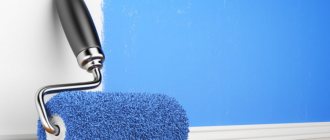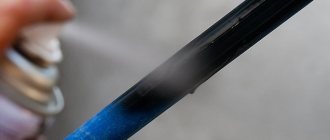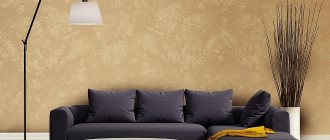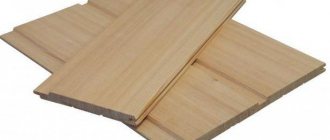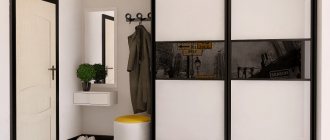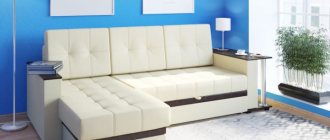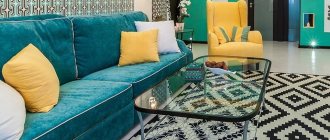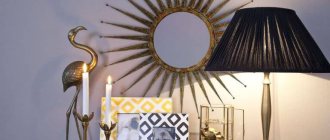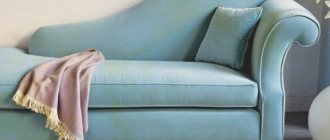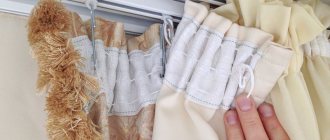Acrylic water-dispersion paint is high-quality and durable, easy to apply to the surface. It is used by craftsmen at industrial facilities. The paint is water-based and contains small particles of acrylate resin.
On the left is acrylic universal water-dispersion paint from Ceresit, on the right is acrylic moisture-resistant water-dispersion paint for walls and ceilings from Yaroslavl paints.
Features of water-dispersion paint
Water-dispersion paint contains polymers - substances consisting of repeating chains of molecules. The coating is a suspension in water of solid particles invisible to the eye - dispersions. The paint comes as a thick white paste. Before use, you must add water and the pigment of the desired color.
When paint is applied to a flat surface, tiny particles “get stuck” on it, and the water evaporates. This results in a smooth, damage-resistant coating.
Types of water-dispersion paints
Water-based paints are divided into three categories, which differ in composition and binding component.
Polyvinyl acetate group
PVA-based solutions are intended for interior work. They can cover ceilings and walls, radiators and plasterboard ceilings. Their only drawback is poor moisture resistance.
The paints are not suitable for use in a bathroom or bathhouse; it is also undesirable to use them in the kitchen. To work with the external walls of the house, you should also choose other varieties of this paint.
Latex group
The latex contained in the paint allows it to withstand “wet” loads. The coating is intended for wet areas.
- This is especially convenient because if the surfaces become dirty, they can be easily washed with both water and household chemicals - the paint will not be damaged.
- But this group also has its weaknesses; the latex coating fades in the sun.
This drawback does not allow the use of a water-repellent solution for building facades or fences.
Acrylic group
Acrylic coating is suitable for both exterior and interior decoration. It fits well on the surface and sticks “tenaciously” to it. This paint is not afraid of rain, hail or wind.
It is resistant to damage and does not crack due to temperature changes. The coating “breathes”, so the wooden beams will not become moldy under it. The consumption of acrylic paints is slightly less than others, although the price is slightly higher.
Product cost
It is best to purchase acrylate compounds in specialized construction stores or trusted chain stores. Buying paint on the market may result in a poor-quality coating obtained as a result of improper storage of the mixture or failure to meet the end date of use.
The price of water-dispersed acrylic paint varies from 150 to 1000 rubles/l or more. The cost is influenced by the popularity of the manufacturer and the performance characteristics of the mixture. The most expensive paints are characterized by high durability and color saturation.
Advice: to reduce the cost of purchasing paint and varnish products, you should purchase paint in larger containers. A correctly calculated amount of material will allow you to avoid overpayments and minimize unspent balances.
Main characteristics of water-dispersion paints
The properties of water-dispersed paints are determined by the following parameters:
- White brightness. Water-based paints are usually white due to the addition of titanium dioxide. The more piercing the whiteness of the solution, the better the paint. This property allows you to achieve a more saturated color when adding pigment. If the water-dispersion paint already has a tint, it is better to discard it: the manufacturer is hiding a product of average quality under the color.
- Covering power. This parameter determines the ability of the paint to cover with its color the shade of the surface on which it is applied. Covering power depends on the density of the paint. The optimal volume-to-weight ratio is when 1 liter of solution weighs 1.5 kg. Thinner paint will lay down in too thin a layer, and thicker paint will increase the consumption of the solution.
- Moisture resistance. Not all groups of paints are able to withstand contact with water; for example, the PVA group does not withstand getting wet. For this reason, it is not suitable for exterior home decoration or bathroom painting. The remaining groups even tolerate the use of detergents.
- Resistant to sunlight. This parameter is important for paint when carrying out external work. If you use latex paint, which has excellent moisture resistance, you will be disappointed when painting a fence or gazebo. The coating will quickly fade in the sun, and the surface will lose its attractiveness. For outdoor work, it is better to take acrylic paints.
- Resistance to mechanical damage. Water-dispersion paints create a hard film on the surface, so it is better to choose based on other properties. Latex paint will perform better in a damp basement, while acrylic paint will perform better outdoors.
All these characteristics allow you to choose the right paint for certain jobs.
Color palette
Initially, latex paints are presented in white. The manufacturing company independently uses the colorant to create the required color. Sometimes even in the store they carry out tinting “to order”. The peculiarity of latex-based products is that they are not presented in bright colors. Using color scheme you can only get pastel colors.
Black latex paint deserves special attention, since it is not often used, but can add a new touch to the interior if used correctly. Bright colors look very beautiful and impressive against a black background. Black paint will eliminate excessive variegation.
When choosing a color scheme, you should also pay attention to what kind of surface you will get after painting - matte or glossy. To hide minor defects and errors, you should use matte paint.
The glossy version will visually make the room more spacious, but the surface for application must be flat.
Benefits of paint
The water-dispersion solution has a number of positive qualities. First of all, it is an environmentally friendly coating because it is water-soluble. It does not have a strong odor and is breathable. Thanks to this latter quality, the material under the coating does not rot or mold.
Several more characteristics can be highlighted:
- Water-based paints do not burn, so they are considered fireproof.
- They are easy to apply; even a beginner can handle this material.
- They last up to 15 years, which means that the surface does not have to be repainted annually.
- The solution dries quickly. After applying the first layer, only 2-3 hours should pass.
- Brushes and rollers can be wiped off with water and detergent after use.
- Due to its moisture resistance, the solution is excellent for treating wooden surfaces outdoors.
- The coating is resistant to damage.
- The paint is affordable.
With so many positive factors, there are also application features that should be adhered to.
How to choose the right one
First of all, if you need to buy water-dispersion paint for finishing work, it is important to determine the necessary performance characteristics that are important for facade finishing. In any case, it is necessary that the material has the highest possible quality indicators, which will create not only a decorative layer, but also provide protection to the structure.
Regarding the purchase of paint, the following factors must be taken into account:
- Country of Origin;
- trademark;
- the area intended for the use of the material;
- availability of a quality certificate;
- best before date;
- storage conditions;
- packaging (usually 15 kg).
IMPORTANT!
It is not recommended to purchase materials that do not come with quality certificates, since there is no guarantee that the brand being purchased is capable of providing the home with the list of stated requirements.
Features of application
When using paint you need to know some nuances. If it is raining or frosty outside, then painting work cannot be carried out, the solution will not dry. In hot weather, the paint will dry so quickly that it can degrade the quality of the coating.
Before using paint, you need to level the surface to perfect smoothness. A thin layer of coating will highlight all the protrusions and “notches” on the wall.
Disadvantages of acrylic solutions
The disadvantages of products do not seem so significant compared to the advantages, but they can play an important role in the choice. Among the negative points stand out:
- Expensive. The price of this composition exceeds the cost of other varieties, which is compensated by the hiding power of the paint. This indicator reduces the number of layers required and mixture consumption.
- Not too high vapor permeability. But this is not always a serious disadvantage. For example, concrete surfaces have low vapor permeability, but they are the ones most often found in ceiling structures that require painting.
When choosing products, all available features are taken into account.
Procedure for working with water-dispersed paints
To work with the coating, you can use a brush or roller. It is better to purchase a roller with a long handle in order to reach all surface levels. The wall in the room must be leveled and primed so that the layers lay correctly.
Paint needed:
- Dilute;
- Add pigment to it;
- Stir thoroughly.
Work should start from the window. The layer is placed both along and across the surface to fill the space evenly. The coating can consist of 1-3 layers. The interval between paintings is 3-4 hours. Approximately 140-180 g of paint is required for 1 m2 of flat surface.
Useful tips
If the water-dispersed paint has been standing for too long and has thickened, it is diluted with water. It is recommended to paint any surfaces at an air temperature of 8–30 ⁰С. If work is carried out outside, exposure to precipitation should be avoided. If paint gets on your hands, it can be easily washed off with warm water and soap.
You should not use this paint for surfaces that quickly become dirty. When dry, it acquires a certain roughness, which contributes to the rapid accumulation of dirt. This should be taken into account in cases where water-based wall paint is used.
The difference between water-based and water-based paints
Both types of coatings are water-based paints, but they have significant differences. Dispersion paints contain hard particles - dispersions; the emulsion solution is filled with liquid inclusions.
There are also differences:
- Dispersion paint forms a stable coating that cannot be washed off with water; emulsion paint does not withstand moisture.
- A thin layer of dispersion paint does not crack due to bad weather and lasts a long time; emulsion paint is less resistant to mechanical damage.
- Emulsion paint is varied in its shades; disperse paint is supplied to the store only in white. The shade is given by additionally added pigment.
- Dispersion paints must be diluted with water; emulsion paints require solvents.
In stores, the cost of water-based coatings is higher than water-dispersion coatings.
Water-dispersion paints are perfect for different types of surfaces, outdoors and indoors. Forming a stable coating, they stand out in rich color and are safe to breathe.
Release form
- aerosol with a sprayer (available in cans up to 500 ml);
- liquid in cans (volume 0.8-1 l);
- in buckets (10, 20, 30 kg).
- during the painting process they lie flat on the surface to be painted;
- The compactness and light weight of the can allow you to paint even hard-to-reach places;
- are stored for a long time without thickening, and are ready for use at any time;
- ease of use (the can can be used by a person who has not previously been involved in painting);
- the paint does not require dilution before painting, so the advantages include the absence of dirty tools that will have to be washed.
